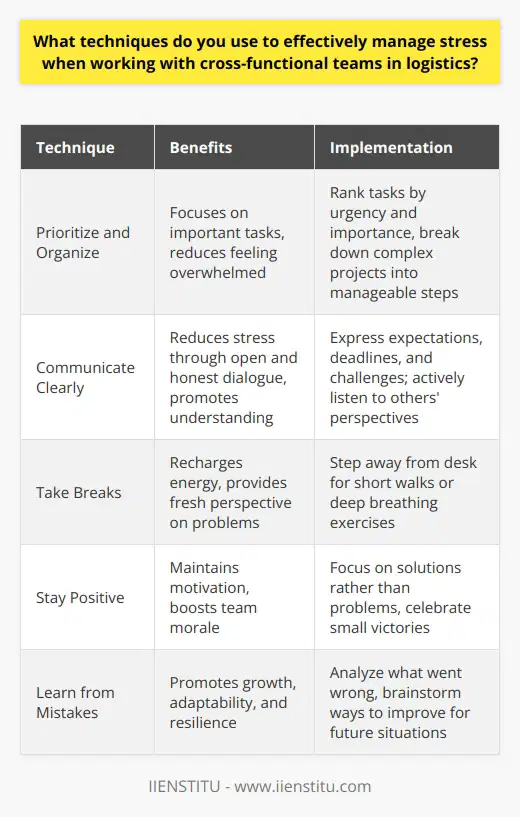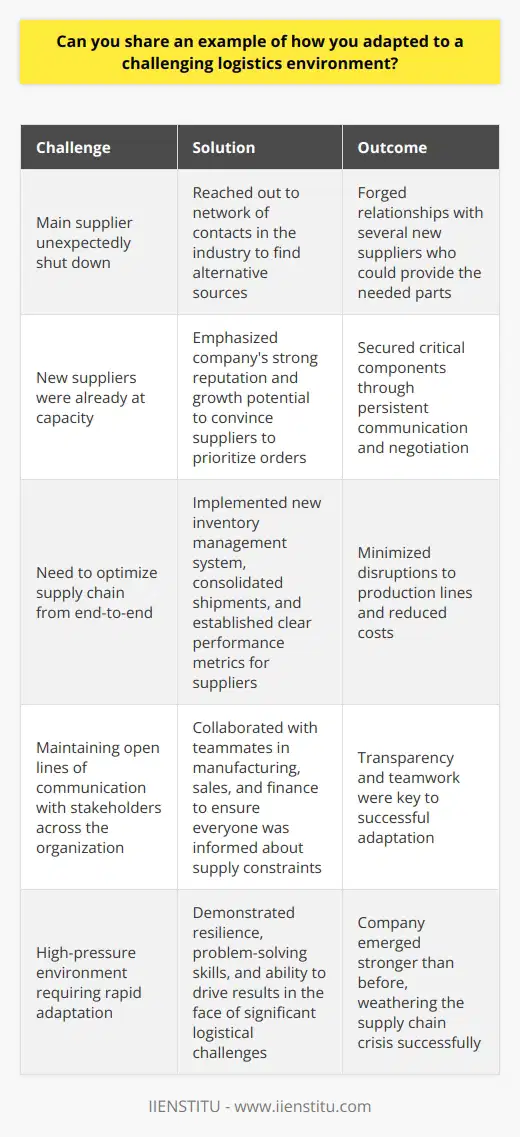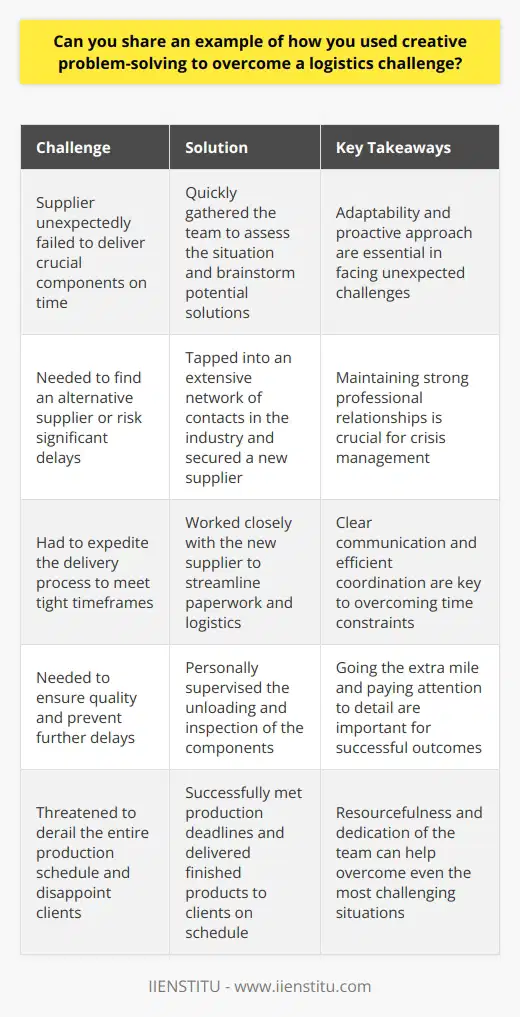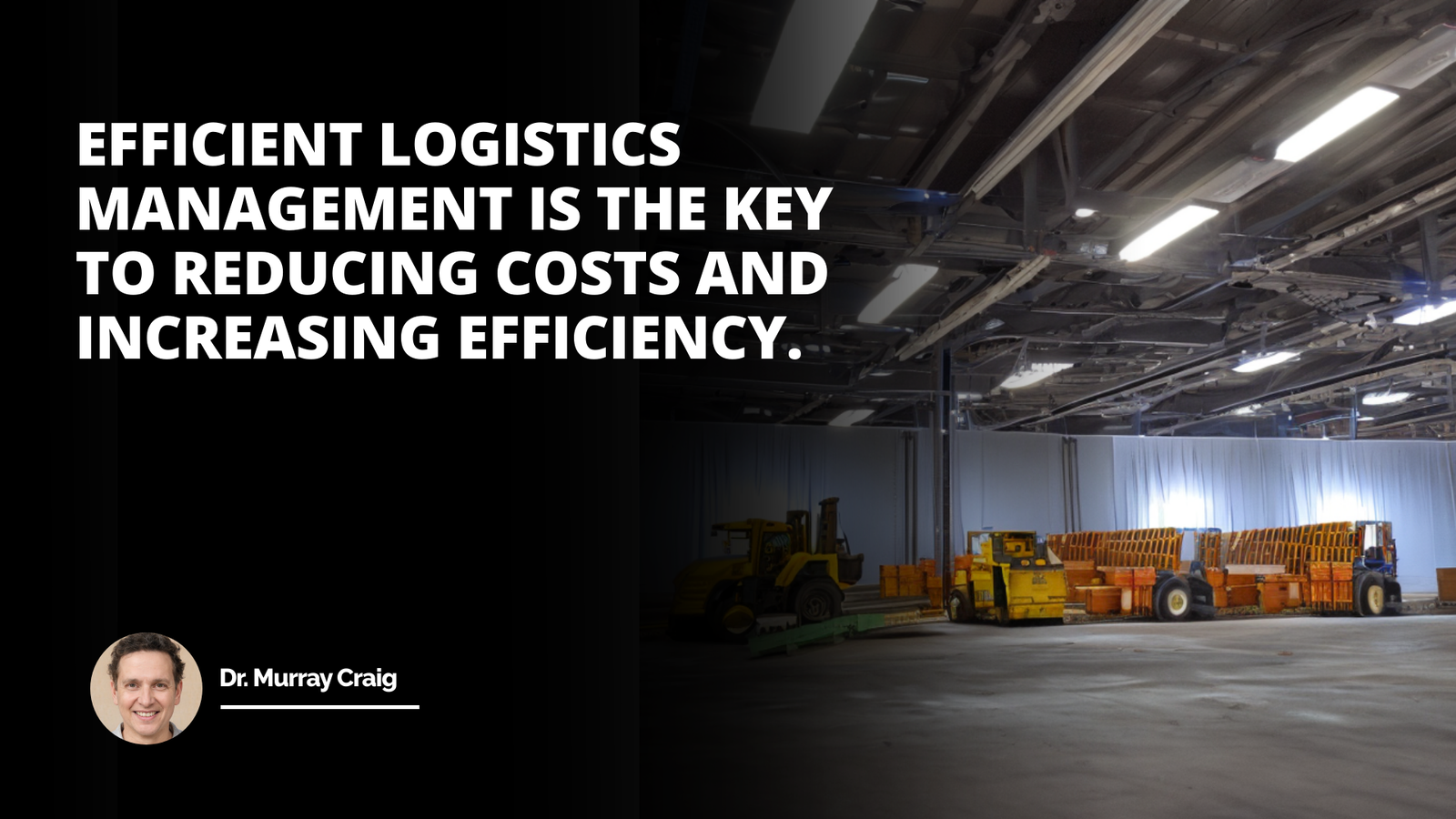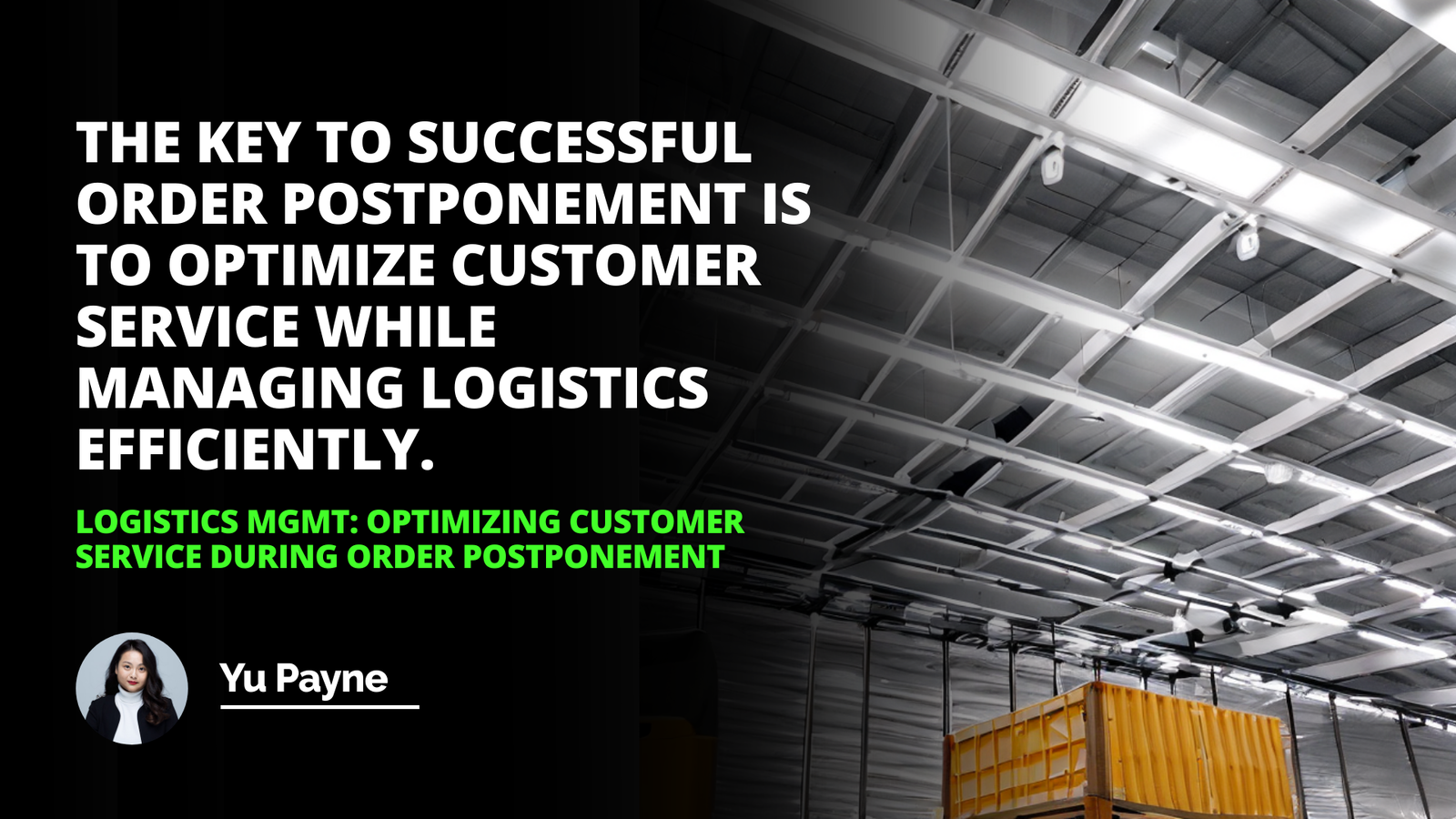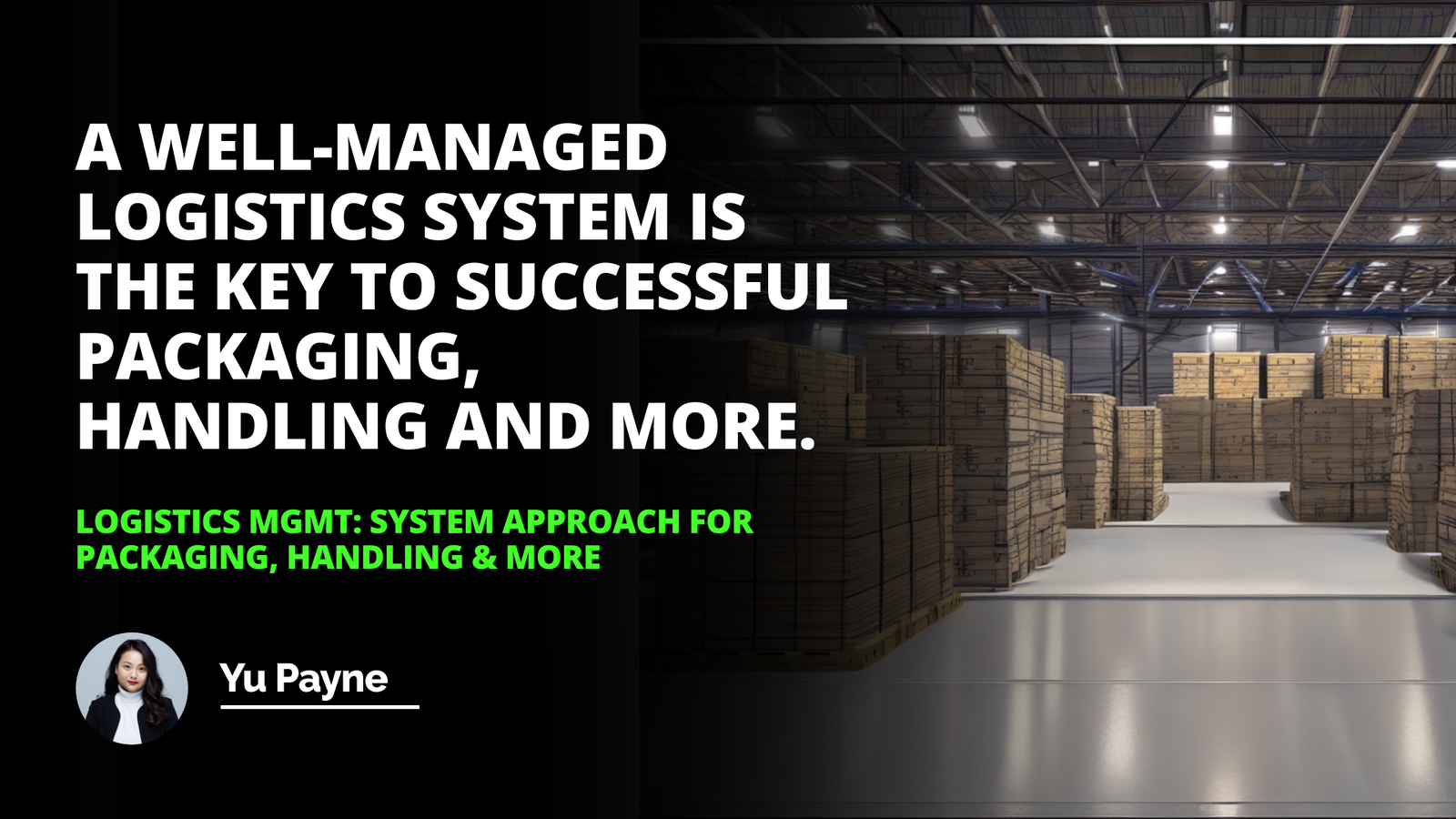
When you're sitting in an interview for a logistics position, you might suddenly encounter an intriguing question—"How do you manage logistics stress?" But why is this question tapestried into the fabric of the interview?
Quite simply, the logistics industry is synonymous with pressure, be it meeting tight timelines or contending with unforeseen supply chain disruptions. Naturally, the question arises—how does one manage logistics stress?
This challenge, laden with pressure-cooker situations, asks for candidates who can stay calm under strain and still deliver impressive results.
The purpose of the question: How do you manage logistics stress?
The main intent behind this question is to analyze the candidate's stress management skills and resilience. It shows how well the candidate can continue to operate efficiently amidst chaotic scenarios.
Related Course: Stress Management Course
Logistics is a complex realm where unanticipated problems may pop up anytime—late deliveries, damaged goods, or miscommunication with distributors, and so forth. As a result, the question seeks to measure the candidate's ability not just to withstand but to thrive under pressure.
At what interview level is "How do you manage logistics stress?" asked?
The question, "Manage logistics stress?", is not reserved solely for senior roles. This vital query is relevant at every interview level in logistics—from logistic coordinators, supply chain analysts, to management roles.
Interview Question: How Do Deadlines Affect Problem Solving?
Interview Question: Describe a Time Management Mistake and Your Learning From It.
Why? Because stress is ubiquitous in logistics; every role faces it—though, of course, the intensity might vary. The question measures the candidate's practical problem-solving skills and resilience, both crucial for any logistics position.
What kind of answer is expected to "How do you manage logistics stress?"
An ideal answer should portray your stress management techniques, mental toughness, and problem-solving capabilities. HR is looking for genuine replies based on real-life experiences, not canned responses.
Mere knowledge won't suffice; your ability to apply that knowledge in pressure situations is the real deal. Show them your stress management tools—be it good communication skills, time management, 'converting stress into motivation,' or using technology to streamline operations.
Related Course: Time Management Online Course Free
Possible answers to "How do you manage logistics stress?"
One possible answer could be, “In my previous role, handling multiple vendors was indeed stress-inducing. However, I identified technology as an ally and introduced an automated system to track vendor performances, which significantly reduced stress and errors.”
Another desirable response could be, “I prioritize tasks and focus on what's most urgent. Delegating is critical to me, too. In my past role, I always made sure to distribute tasks evenly among the team members to avoid stress overload on a single person.”
Or perhaps, “I believe in converting stress into motivation. Whenever faced with intense pressure, I remind myself of the accomplishments I’ve made in such scenarios before—this helps me remain unfazed and keenly focused on the task at hand.”
Considerations when answering "Manage logistics stress"
Finally, when answering, remember to be specific with your instances—describe the situation, your action, and the result. Stories resonate well with interviewers as they provide tangible evidence of your abilities.
Also, while demonstrating how you manage logistics stress, ensure your strategies are adaptable and innovative. In logistics, one size does not fit all, and the interviewer will regard your adaptability and innovative thinking as an asset for the company.
Authenticity is important. Don't embellish or falsify experiences, and remember—free-flowing conversation is a tool to display your knowledge, ability, and persona. Be sure to convey your resilience, your knack for problem-solving, and, most importantly, your ability to manage logistics stress.
Remember, the purpose of this question is not to overwhelm you with stress, but to demonstrate your resilience and your ability to handle stress. It's your opportunity to show that not only can you handle stress, but you can thrive under it.
Take a deep breath, put on a confident smile, and go ace that question. After all, what is logistics without a bit of pressure? It's just another chance to shine!
Stress Management Techniques in Logistics Operations
Impact of Stress on Logistics Efficiency
Strategies to Reduce Stress in Logistics Management
Related Course: Logistics Certification Courses
Similar interview questions:
How can one alleviate stress associated with logistics management?
What strategies have proven effective in reducing stress in managing logistics?
What is your approach in managing stress in the logistics field?
Are there any methods that you have found to help manage the stress in logistics?
Can you provide any tips on how to reduce stress while managing logistics?
What should one do to manage the pressures and stresses often encountered in logistics management?
Are there any systematic approaches to control stress in the management of logistics?
What are some of the ways to handle stress within the logistics management sector?
Have you discovered any solutions for managing the stressful aspects of logistics coordination?
Can you identify any effective techniques for stress management in the field of logistics?
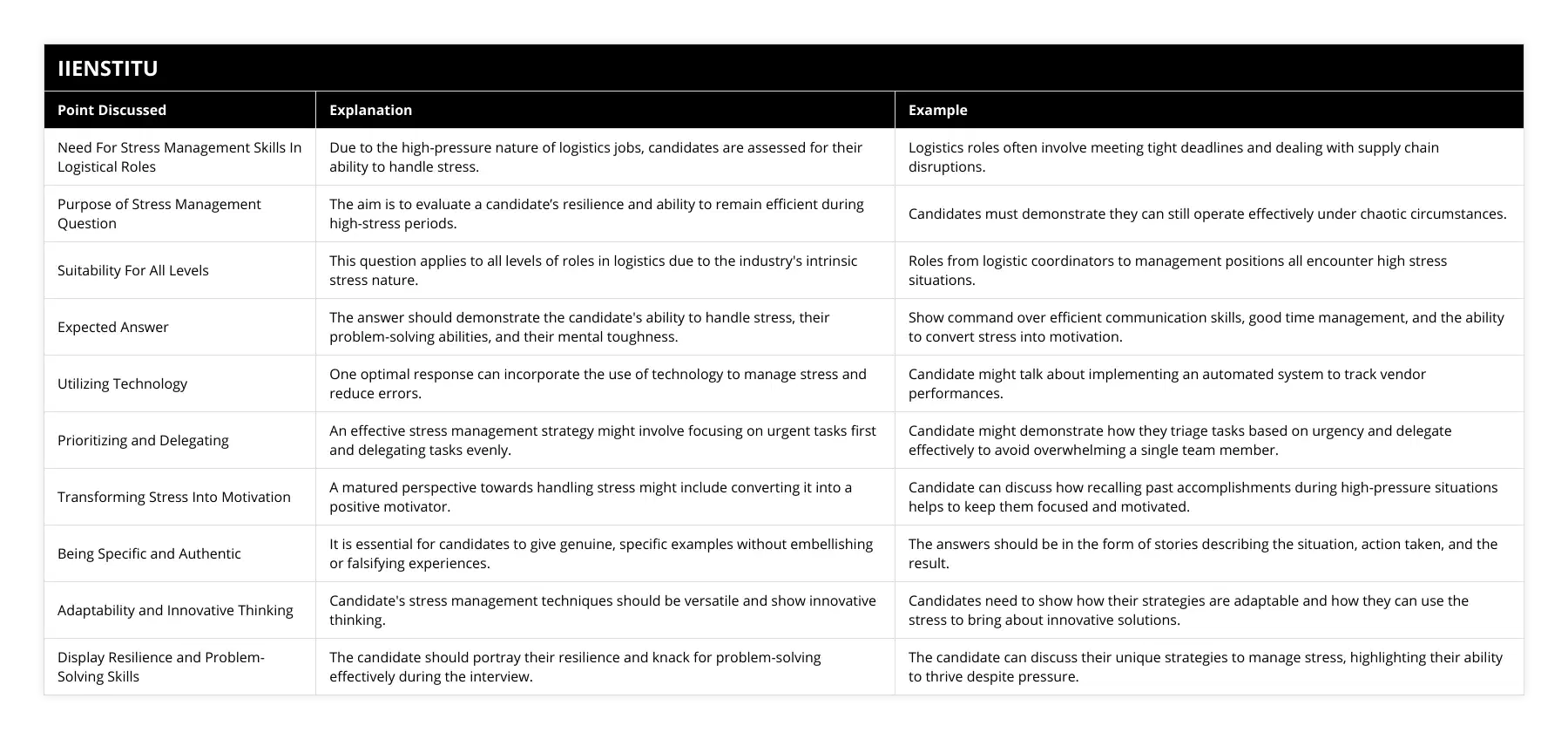
Frequently Asked Questions
How do you prioritize tasks when faced with multiple deadlines?
When faced with multiple deadlines, I prioritize tasks based on their urgency and importance. I start by making a list of all the tasks that need to be completed and their respective deadlines. Then, I categorize them based on their level of urgency and importance.
Urgency and Importance Matrix
I use the Eisenhower Matrix to categorize tasks into four quadrants:
1. Urgent and Important
These tasks require immediate attention and have significant consequences if not completed on time. I tackle these tasks first.
2. Important but Not Urgent
These tasks are crucial for long-term goals but don't have pressing deadlines. I schedule time for these tasks after completing urgent ones.
3. Urgent but Not Important
These tasks demand immediate attention but don't contribute much to overall goals. I try to delegate or minimize time spent on these tasks.
4. Neither Urgent nor Important
These tasks are not critical and can be postponed or eliminated. I focus on them only if time permits.
Communication and Collaboration
I believe in open communication with my team and supervisors. If I feel overwhelmed or need guidance, I reach out to them. Collaborating with colleagues can also help in distributing workload and meeting deadlines efficiently.
Flexibility and Adaptability
Despite careful planning, unexpected challenges can arise. I remain flexible and adapt my priorities as needed. If a new urgent task comes up, I re-evaluate my list and make necessary adjustments.
By following this approach, I've been able to consistently meet deadlines and deliver quality work. I remember a time when I had three projects due within a week. By prioritizing based on urgency and importance, communicating with my team, and staying flexible, I managed to complete all three projects successfully and received positive feedback from my supervisors.
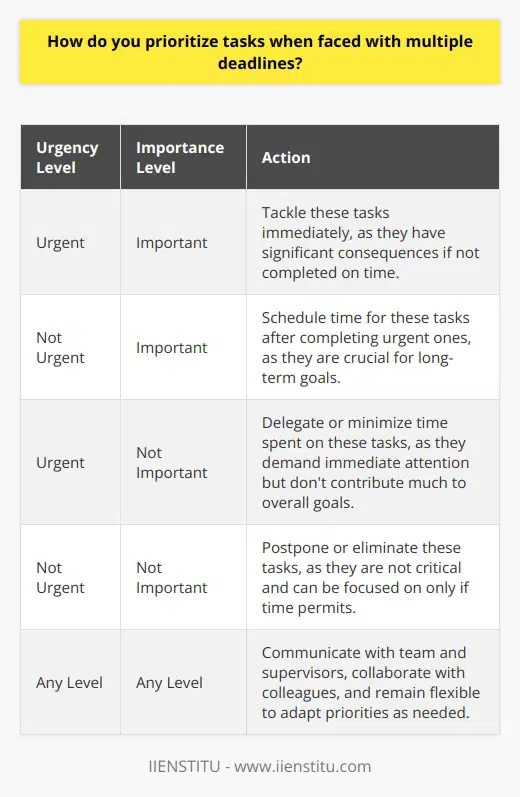
What strategies do you use to remain calm under pressure?
When faced with high-pressure situations, I have developed several strategies to maintain composure and perform at my best. One key approach is thorough preparation and planning. By anticipating potential challenges and rehearsing how to handle them, I feel more confident and in control.
Mindfulness and Deep Breathing
In the moment, I find that mindfulness techniques like deep breathing help me stay centered. Taking a few slow, deliberate breaths allows me to clear my head and refocus. It's a simple but powerful way to hit the reset button when stress starts building up.
Positive Self-Talk
Another strategy I rely on is positive self-talk and visualization. Before heading into a high-stakes situation, I mentally walk through the scenario while picturing myself remaining calm, articulate and impressive. Silently reassuring myself with phrases like "You've got this" and "One step at a time" boosts my confidence.
Embracing the Challenge
Over the years, I've also learned to reframe pressure as a positive. Rather than getting intimidated, I try to view challenging moments as opportunities to learn, grow and shine. Embracing the adrenaline rush with a sense of enthusiasm versus dread helps me stay poised and rise to the occasion.
At the end of the day, I've found staying calm under pressure is a skill that gets stronger with practice. Each high-stress experience is a chance to build resilience and fine-tune these strategies. Missteps sometimes still happen, but I aim to greet them with self-compassion, extract lessons and keep improving. Pressure may be inevitable, but with the right mindset and tools, I believe we can thrive in spite of it - and often because of it.
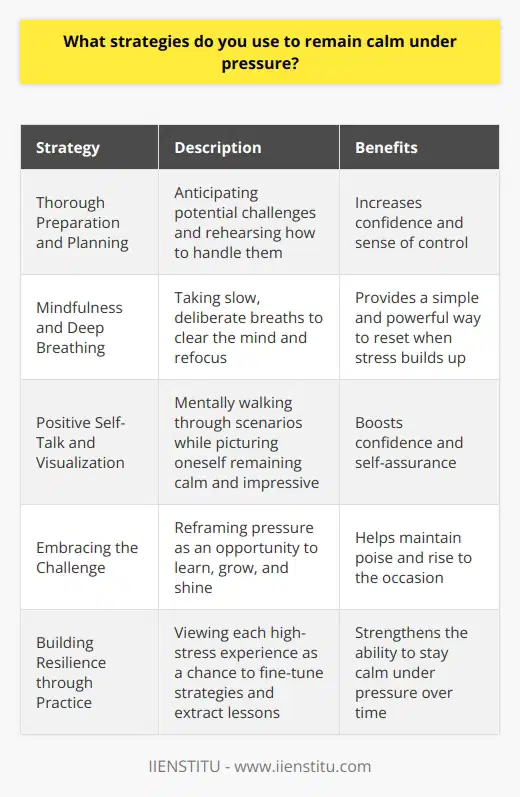
How do you handle unexpected changes in logistics plans?
When it comes to handling unexpected changes in logistics plans, I believe in staying calm and composed. From my experience working as a project manager, I've learned that panicking only makes things worse. Instead, I take a step back and assess the situation objectively.
Gather Information
The first thing I do is gather all the relevant information about the change. I try to understand what caused it and how it impacts our overall plan. This helps me identify potential solutions and alternatives.
Communicate with Stakeholders
Next, I communicate the change to all stakeholders involved. I explain the situation clearly and concisely, ensuring everyone is on the same page. Transparency is key in such situations, as it helps build trust and cooperation.
Develop a Contingency Plan
Once I have all the information and everyone is informed, I work on developing a contingency plan. I brainstorm ideas with my team and consider different scenarios. We weigh the pros and cons of each option before deciding on the best course of action.
Implement and Monitor
After finalizing the contingency plan, I ensure it is implemented smoothly. I assign clear roles and responsibilities to team members and provide them with the necessary resources. Throughout the process, I closely monitor progress and make adjustments as needed.
Learn and Improve
Finally, I believe in learning from every experience, even unexpected changes. I take note of what worked well and what didn't, so we can improve our processes for future projects. Continuous improvement is essential for success in any field.
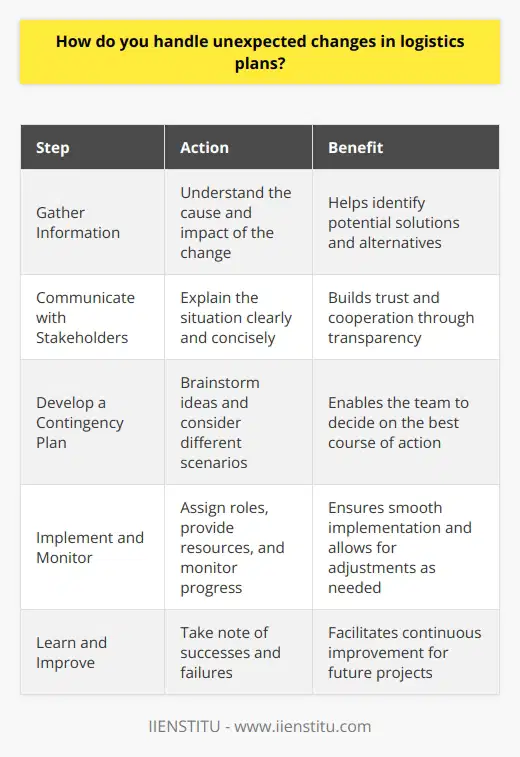
Can you describe a time when you successfully managed a stressful logistics situation?
In my previous role as a logistics coordinator, I encountered a particularly stressful situation during the peak holiday season. Our main supplier had a major production delay, which meant we wouldn't receive our inventory in time to fulfill customer orders.
Assessing the Situation
I quickly realized the gravity of the situation and its potential impact on our business. I knew I had to act fast to find a solution and prevent disappointing our customers.
Developing a Plan
I immediately scheduled a meeting with my team to brainstorm alternative solutions. We considered various options, such as sourcing from other suppliers, expediting shipping, and offering substitute products.
After weighing the pros and cons of each option, we decided to split our efforts. We would source a portion of the inventory from a reliable backup supplier while offering customers the option to choose a substitute product or wait for their original order.
Communicating with Stakeholders
I personally reached out to our key customers to explain the situation and present the available options. I listened to their concerns and worked with them to find the best solution for their specific needs.
Meanwhile, I maintained close communication with our suppliers, monitoring the progress of both the original and backup orders. I provided regular updates to my team and upper management to ensure everyone was on the same page.
Successful Resolution
Thanks to our proactive approach and effective communication, we were able to fulfill the majority of customer orders on time. We received positive feedback from customers who appreciated our transparency and efforts to accommodate their needs.
Through this experience, I learned the importance of staying calm under pressure, thinking creatively, and collaborating with others to find solutions. I'm proud of how our team came together to overcome this challenge and maintain our commitment to customer satisfaction.
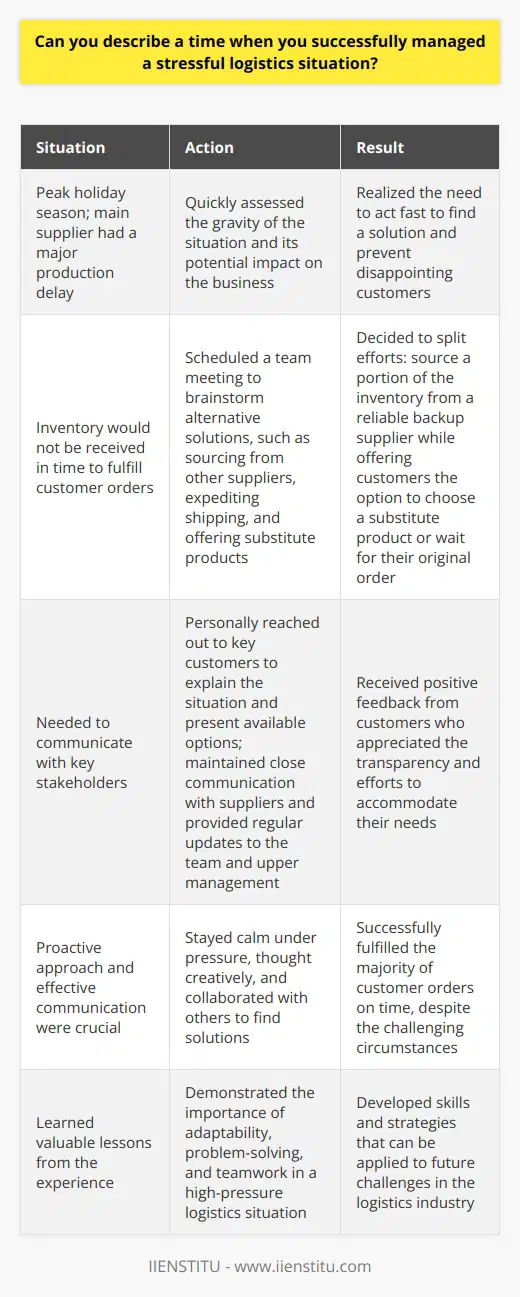
What techniques do you employ to prevent burnout in a high-pressure logistics role?
To prevent burnout in a high-pressure logistics role, I employ several techniques that help me stay focused, energized, and motivated.
Prioritizing Self-Care
I make sure to prioritize my physical and mental well-being by maintaining a regular exercise routine and practicing mindfulness. Taking short breaks throughout the day to stretch, meditate, or simply breathe deeply helps me recharge and maintain a positive outlook.
Effective Time Management
I use time management tools like calendars, to-do lists, and project management software to stay organized and on track. By breaking down large tasks into smaller, manageable steps, I can avoid feeling overwhelmed and maintain a steady pace of progress.
Maintaining Work-Life Balance
I set clear boundaries between my work and personal life, making sure to disconnect from work during my off-hours. Spending quality time with family and friends, pursuing hobbies, and engaging in activities that bring me joy help me maintain a healthy work-life balance.
Continuous Learning and Growth
I actively seek opportunities to learn new skills and expand my knowledge in the logistics field. Attending workshops, conferences, and training sessions not only helps me stay up-to-date with industry trends but also keeps me engaged and motivated in my work.
By implementing these techniques, I have been able to maintain a high level of performance and job satisfaction in even the most demanding logistics roles. I am confident that my approach to preventing burnout will enable me to thrive in this position and contribute to the success of your organization.
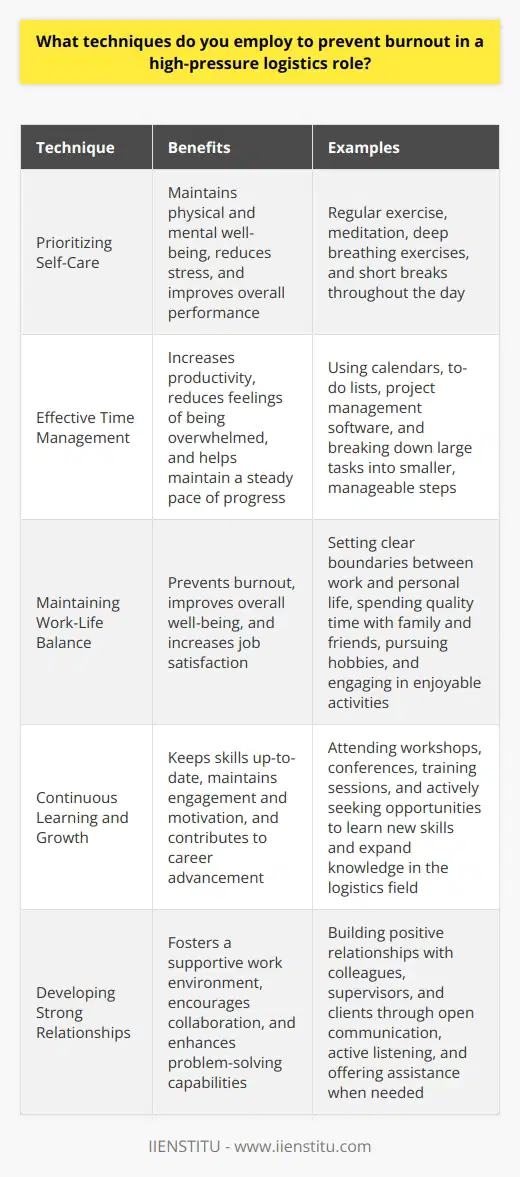
How do you communicate with team members and stakeholders during stressful periods?
During stressful periods, I prioritize clear and frequent communication with my team members and stakeholders. I believe in being proactive and keeping everyone informed about project updates, potential challenges, and any changes in timelines or expectations.
Transparency and Honesty
I always strive to be transparent and honest in my communication. When faced with a challenging situation, I don't hesitate to share my concerns and seek input from others. By fostering an open and collaborative environment, we can work together to find solutions and navigate through the stressful times.
Active Listening
Active listening is key to effective communication, especially during stressful periods. I make a conscious effort to listen attentively to my team members and stakeholders, ensuring that I understand their perspectives and concerns. By valuing their input and ideas, we can build trust and work towards a common goal.
Regular Check-Ins
I schedule regular check-ins with my team members to discuss progress, address any issues, and provide support. These check-ins can be in the form of stand-up meetings, one-on-one conversations, or team huddles. By maintaining open lines of communication, we can identify and resolve problems quickly, reducing stress and maintaining productivity.
Adapting Communication Styles
I understand that different individuals have different communication preferences, especially during stressful times. Some may prefer email updates, while others may appreciate a quick phone call or face-to-face meeting. I try to adapt my communication style to meet the needs of each team member and stakeholder, ensuring that everyone feels heard and supported.
At the end of the day, effective communication is about building strong relationships, fostering collaboration, and working together to overcome challenges. By prioritizing transparency, active listening, regular check-ins, and adapting to individual communication styles, I aim to navigate through stressful periods with my team members and stakeholders, emerging stronger and more united.
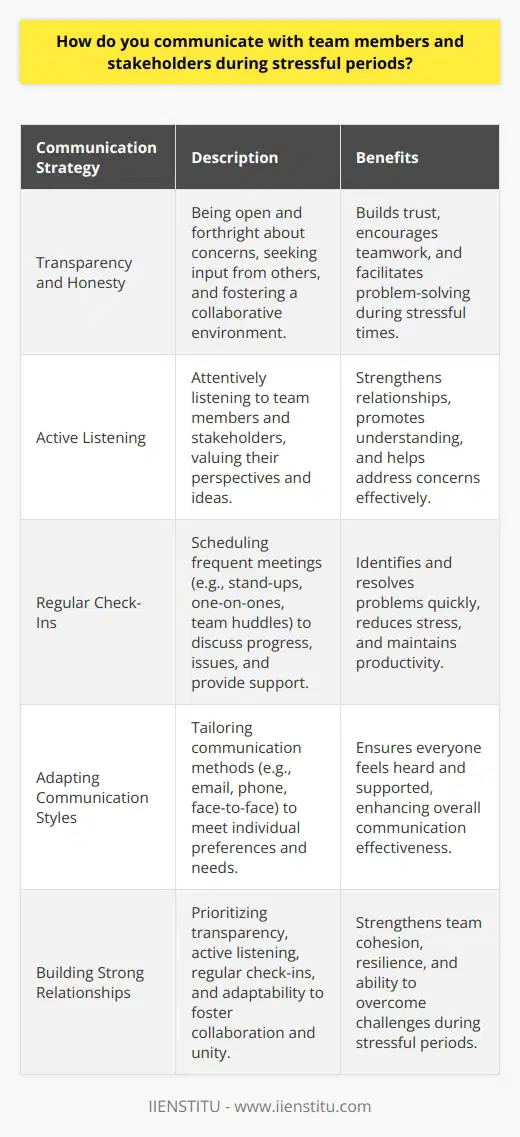
What methods do you use to stay organized and on top of your workload?
I use a combination of digital tools and physical methods to stay organized and manage my workload effectively. My go-to app is Trello, which allows me to create task lists, set deadlines, and track progress. I'm a big fan of the Kanban board view, as it gives me a visual overview of what needs to be done.
Prioritizing Tasks
Each morning, I review my tasks and prioritize them based on urgency and importance. I tackle the most critical items first, ensuring that I'm making steady progress on my key responsibilities. If something unexpected comes up, I adjust my priorities accordingly.
Breaking Down Projects
When faced with a large project, I break it down into smaller, manageable tasks. This helps me avoid feeling overwhelmed and allows me to focus on one step at a time. I set milestones and celebrate small wins along the way, which keeps me motivated.
Staying Focused
To minimize distractions, I use the Pomodoro Technique. I work in 25-minute intervals, followed by short breaks. This helps me maintain focus and avoid burnout. I also use noise-canceling headphones when I need to concentrate on a task.
Keeping a Clean Workspace
I find that a cluttered desk leads to a cluttered mind. That's why I make a point to keep my workspace tidy and organized. At the end of each day, I take a few minutes to clear my desk and prepare for the next day.
By using a combination of digital tools, prioritization techniques, and physical organization methods, I'm able to stay on top of my workload and deliver high-quality work consistently.
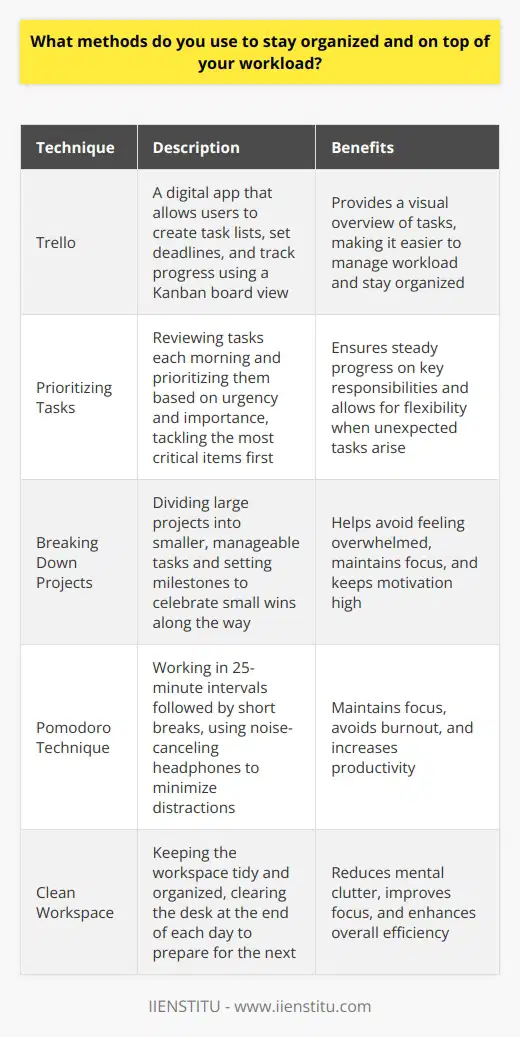
How do you maintain a healthy work-life balance in a demanding logistics position?
Maintaining a healthy work-life balance in a demanding logistics position requires discipline, organization, and clear boundaries. I've found that prioritizing my tasks and focusing on the most critical responsibilities during work hours is essential. This allows me to be productive and efficient, reducing the likelihood of work spilling into my personal time.
Setting Boundaries and Expectations
One key strategy I employ is openly communicating with my colleagues and supervisors about my availability outside of work hours. By setting clear expectations upfront, I can minimize interruptions during my personal time, barring true emergencies.
Prioritizing Self-Care and Personal Relationships
I also make a conscious effort to prioritize self-care and nurture my relationships outside of work. Whether it's scheduling regular exercise, pursuing hobbies, or dedicating time to family and friends, I treat these commitments with the same importance as my professional obligations.
Leveraging Technology and Delegation
To streamline my workload, I leverage technology tools that automate repetitive tasks and improve efficiency. Additionally, I'm not afraid to delegate responsibilities when appropriate, empowering my team members and fostering a collaborative work environment.
Reflecting and Adjusting
Maintaining a healthy work-life balance is an ongoing process that requires regular reflection and adjustment. I periodically assess my priorities and make changes as needed to ensure that I'm meeting both my professional and personal goals. By staying adaptable and proactive, I can navigate the demands of my logistics position while still leading a fulfilling life outside of work.
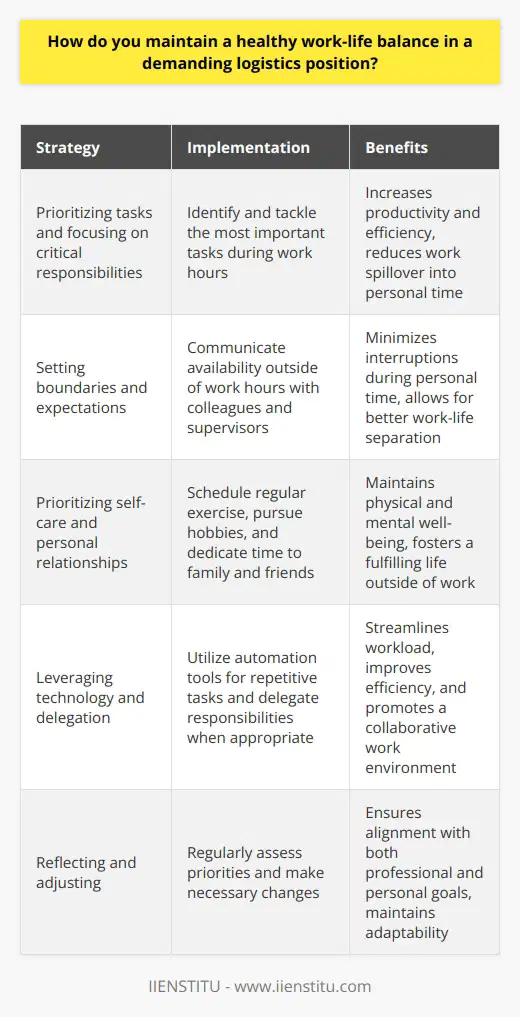
What steps do you take to anticipate and mitigate potential logistics problems?
When it comes to anticipating and mitigating potential logistics problems, I take a proactive approach. I believe in the power of thorough planning and preparation to prevent issues from arising in the first place.
Conduct Extensive Research
Before embarking on any project or initiative, I dive deep into research. I gather all the necessary information about the logistics involved, from transportation routes to supplier capabilities. By having a comprehensive understanding of the landscape, I can identify potential bottlenecks and risks early on.
Develop Contingency Plans
Once I've mapped out the logistics, I create detailed contingency plans. I ask myself, "What could possibly go wrong at each stage?" From there, I devise alternative solutions and backup strategies. Whether it's securing multiple suppliers or planning alternate shipping methods, I ensure there are always fallback options ready to deploy.
Foster Open Communication
Clear and timely communication is key to mitigating logistics problems. I make it a point to establish open lines of communication with all stakeholders involved. By keeping everyone informed and aligned, we can quickly address any issues that may arise and collaborate on swift resolutions.
Continuously Monitor and Adapt
Even with the best-laid plans, unexpected challenges can occur. That's why I believe in continuous monitoring and adaptation. I closely track the progress of logistics operations, using real-time data and insights to make informed decisions. If I notice any deviations or red flags, I promptly reassess and adjust our approach to keep things on track.
At the end of the day, anticipating and mitigating logistics problems is all about being proactive, prepared, and agile. By staying one step ahead and having a robust contingency plan in place, I can navigate even the most complex logistics challenges with confidence and efficiency.
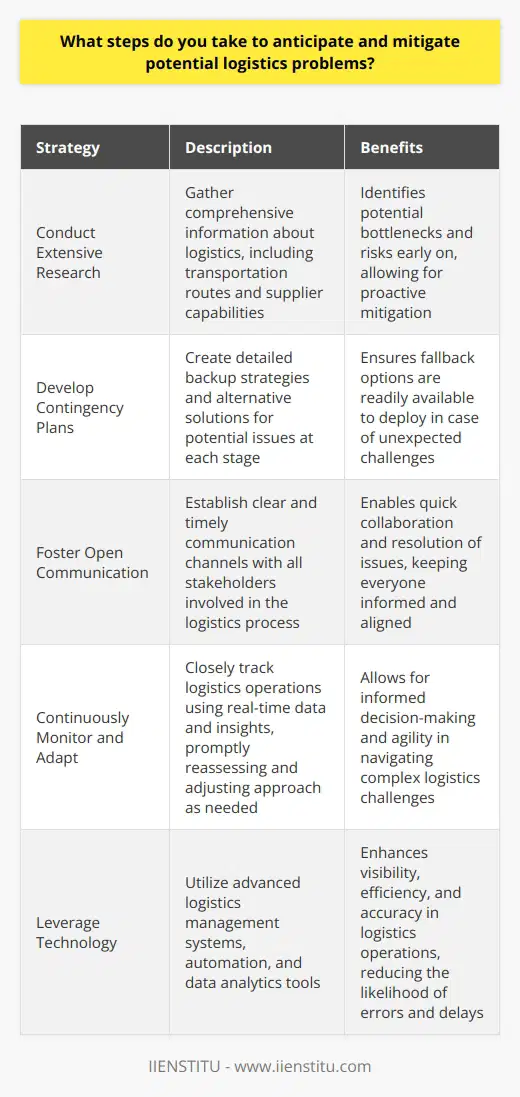
How do you foster collaboration among team members during stressful projects?
Fostering collaboration among team members during stressful projects is crucial for success. I believe in leading by example and maintaining a positive attitude, even when things get tough. This helps keep morale up and encourages everyone to work together towards our common goal.
Encourage Open Communication
I make it a priority to have regular check-ins with my team, both as a group and individually. This gives everyone a chance to voice concerns, share ideas, and get feedback. When people feel heard, they're more likely to collaborate effectively.
Another strategy I use is to create a safe space for brainstorming and problem-solving. There are no bad ideas during these sessions - we explore all possibilities before deciding on the best course of action. This inclusivity fosters a sense of teamwork and shared ownership over the project.
Clarify Roles and Responsibilities
Stress often arises when there's confusion about who's doing what. To prevent this, I work with my team to clearly define everyone's roles and responsibilities at the outset of a project. We document this in a shared project plan that gets updated as things evolve.
Having this clarity helps us hold each other accountable and ensures no important tasks fall through the cracks. It also allows team members to focus on their strengths, which boosts both efficiency and morale.
Celebrate Wins Along the Way
When a project is stressful, it's easy to put your head down and just plow through. However, I've found it's essential to take moments to acknowledge progress and celebrate small victories along the way. Whether it's sending a congratulatory email, giving a shout-out during a meeting, or bringing in coffee and donuts, a little recognition goes a long way.
These celebrations serve as a reminder that we're making headway, even when things are tough. They help bond the team and give everyone a much-needed boost to keep pushing forward.
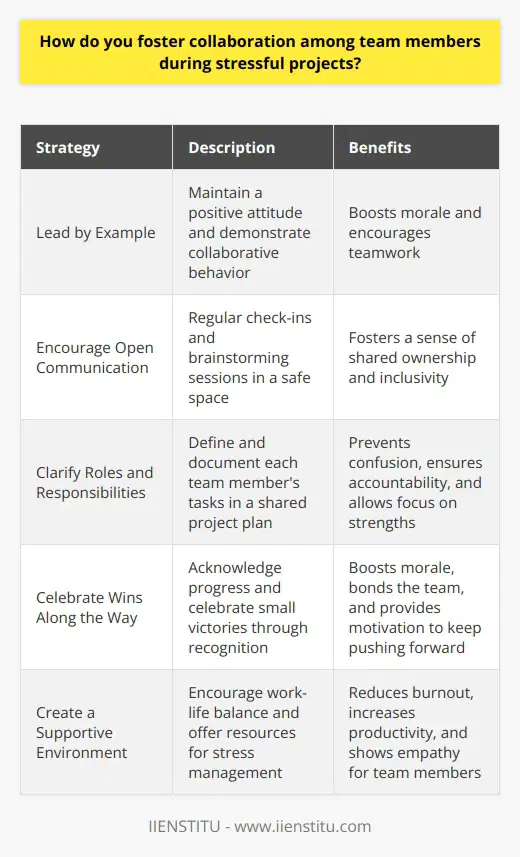
What tools or technologies do you rely on to streamline logistics processes and reduce stress?
In my experience, I've found that using project management software like Asana or Trello helps streamline logistics processes. These tools allow me to create tasks, set deadlines, and collaborate with team members easily. I also rely on cloud storage solutions such as Google Drive or Dropbox to securely store and share files.
Automating repetitive tasks
To reduce stress and save time, I automate repetitive tasks whenever possible. For example, I use Zapier to connect different apps and create workflows that handle tasks like data entry or email follow-ups. This frees me up to focus on more important responsibilities.
Staying organized with calendar apps
Staying organized is crucial for managing logistics effectively. I use calendar apps like Google Calendar to schedule meetings, set reminders, and keep track of important dates. This helps me stay on top of my tasks and avoid last-minute rushes that can be stressful.
Communicating effectively with team members
Clear communication is essential for streamlining logistics processes. I use messaging apps like Slack or Microsoft Teams to communicate with team members in real-time. This allows us to quickly resolve issues, share updates, and ensure everyone is on the same page.
By leveraging these tools and technologies, I'm able to streamline logistics processes, reduce stress, and work more efficiently. I'm always on the lookout for new solutions that can help me improve my workflow even further.
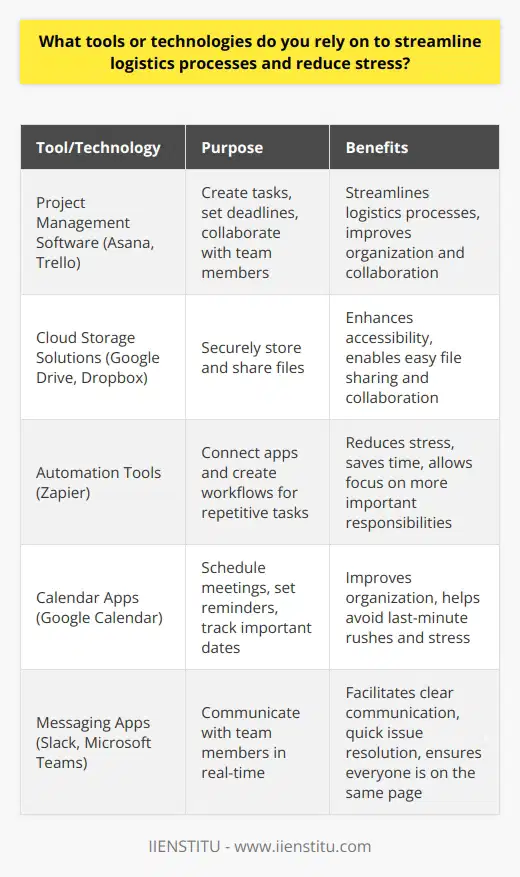
How do you handle conflicts or disagreements that arise in a fast-paced logistics setting?
When conflicts or disagreements arise in a fast-paced logistics setting, I handle them calmly and professionally. I listen actively to understand each person's perspective before responding. Gathering all the facts helps me see the full picture.
Communicate Clearly
I communicate clearly and directly to address issues. Focusing on specific behaviors and impacts, not personalities, keeps discussions productive. I look for win-win solutions that meet everyone's key needs as much as possible.
Stay Solution-Oriented
Dwelling on problems saps morale and momentum. I stay solution-oriented to keep the team moving forward. When emotions run high, I suggest a brief break to let everyone regroup with cooler heads.
Escalate When Needed
If the disagreement reaches an impasse, I'm not afraid to respectfully escalate to a manager or HR. Sometimes a neutral third party is needed to mediate and resolve stubborn conflicts.
Learn and Move On
Once a resolution is reached, I do my part to implement it fully. Holding grudges only breeds more conflict. I aim to learn from each situation and move on as a stronger, more cohesive team.
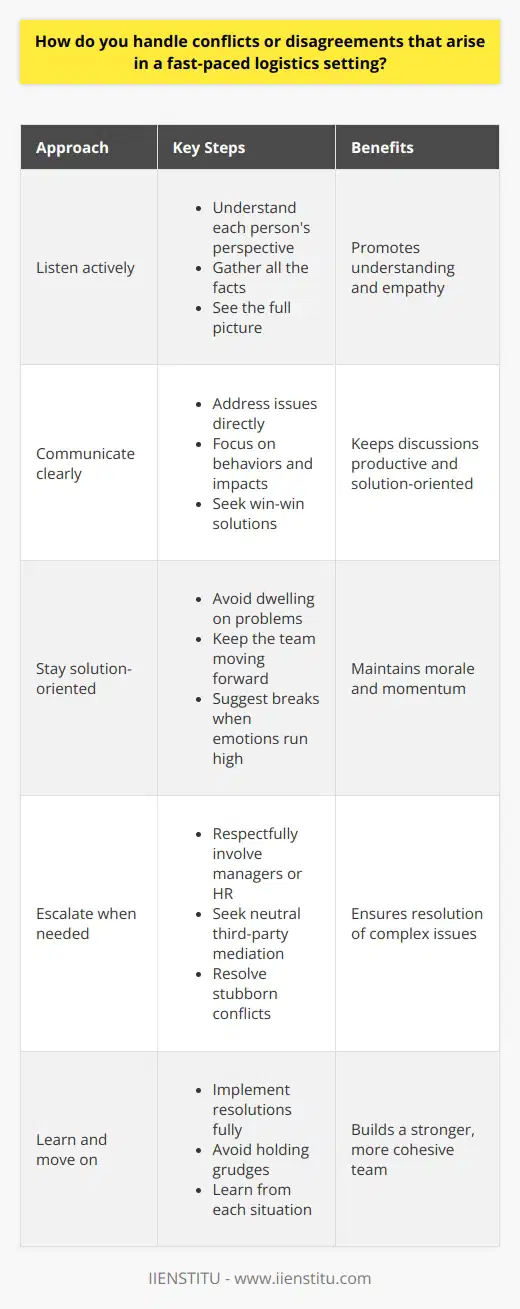
Can you describe your approach to problem-solving when faced with logistics challenges?
When faced with logistics challenges, I approach problem-solving by first identifying the root cause of the issue. This involves gathering data, analyzing trends, and collaborating with stakeholders to gain a comprehensive understanding of the situation.
Breaking Down the Problem
Once I have a clear grasp of the problem, I break it down into smaller, manageable components. This allows me to prioritize the most critical aspects and develop targeted solutions for each part of the challenge.
Brainstorming and Collaboration
I believe in the power of brainstorming and collaboration when it comes to problem-solving. I engage with my team, leveraging their diverse perspectives and expertise to generate creative ideas and potential solutions.
Evaluating and Implementing Solutions
After collecting a range of possible solutions, I evaluate each one based on feasibility, impact, and alignment with company goals. I then develop an implementation plan, outlining clear steps, timelines, and responsibilities to ensure smooth execution.
Monitoring and Adaptability
Throughout the implementation process, I closely monitor progress and remain adaptable to changing circumstances. If a solution isn't yielding the desired results, I'm not afraid to pivot and explore alternative approaches.
Ultimately, my problem-solving approach is rooted in a data-driven, collaborative, and adaptable mindset. I believe in taking a systematic yet creative approach to tackle logistics challenges head-on and drive positive outcomes for the organization.
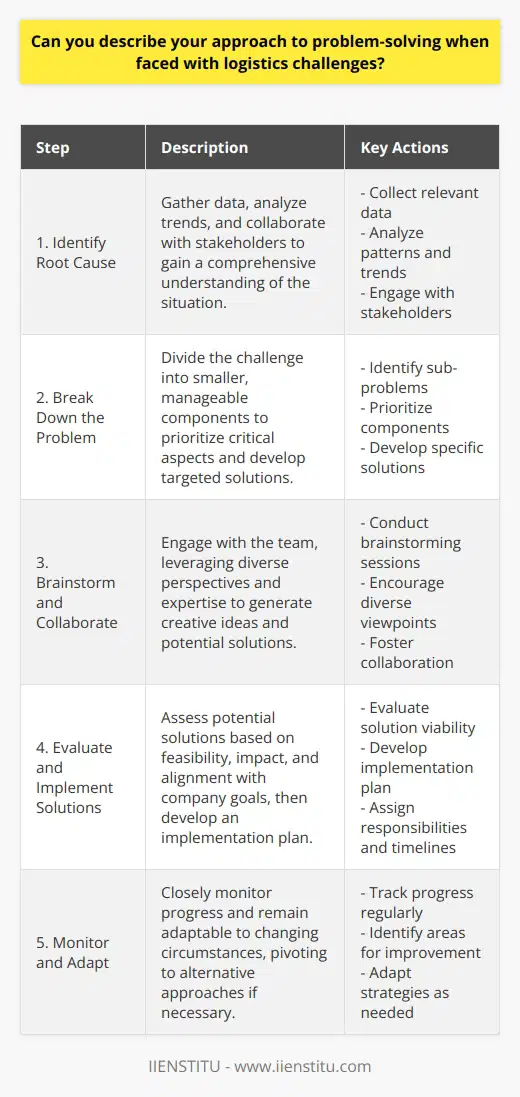
What strategies do you use to maintain effective communication with clients during high-pressure situations?
When faced with high-pressure situations involving clients, I rely on a few key strategies to maintain effective communication. First and foremost, I make it a priority to remain calm and composed, even when tensions are running high. This helps me think clearly and respond in a professional manner.
Active Listening
One of the most important strategies I employ is active listening. I give the client my full attention, allowing them to express their concerns and feelings without interruption. By showing empathy and understanding, I can often diffuse difficult situations and find common ground.
Clear and Concise Communication
When it's my turn to speak, I focus on being clear and concise. I avoid using jargon or technical terms that might confuse the client, and instead break down complex ideas into easy-to-understand language. I also make sure to address the client's specific concerns and offer practical solutions whenever possible.
Staying Solution-Oriented
Another strategy I find effective is to stay solution-oriented. Instead of dwelling on the problem or placing blame, I focus on finding a resolution that works for everyone involved. This might involve brainstorming ideas with the client, offering alternative approaches, or simply reassuring them that we're working towards a positive outcome.
Follow-Up and Transparency
Finally, I believe in the importance of follow-up and transparency. After a high-pressure situation has been resolved, I make sure to check in with the client to ensure they're satisfied with the outcome. I also keep them informed throughout the process, providing regular updates and being honest about any challenges or setbacks we may encounter along the way.
By using these strategies consistently, I've been able to build strong relationships with clients and maintain effective communication even in the most challenging circumstances.
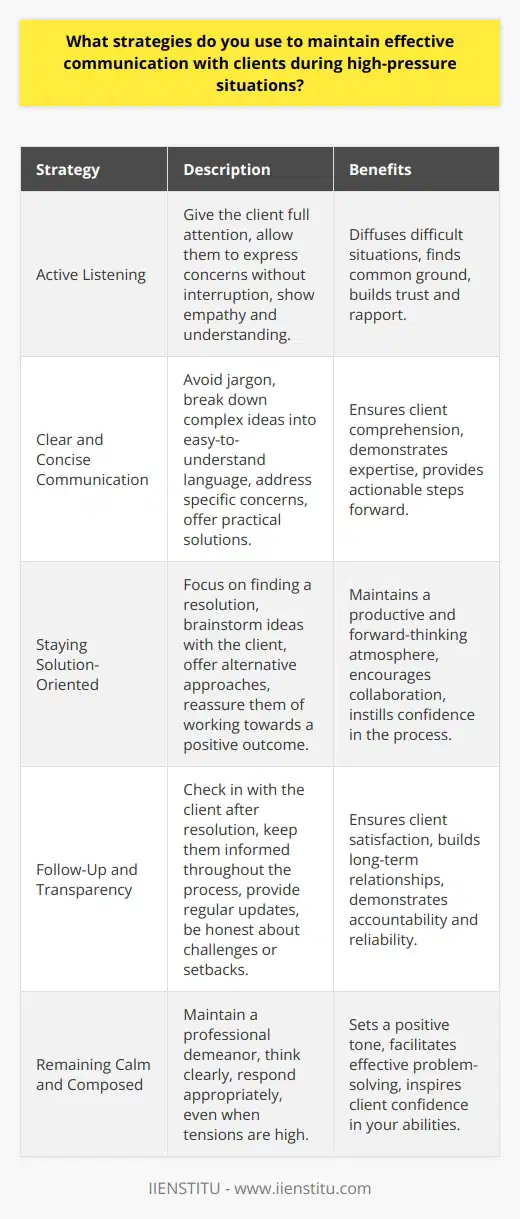
How do you ensure accuracy and attention to detail when working under stress?
When working under stress, I have a few strategies to ensure accuracy and attention to detail. First, I take a moment to breathe deeply and clear my mind. This helps me focus on the task at hand.
Double-checking My Work
I always make sure to double-check my work, even if I'm in a rush. I find that taking an extra minute or two to review can catch any potential errors. It's better to spend a little more time upfront than to have to fix mistakes later.
Breaking Tasks into Manageable Steps
When I'm feeling overwhelmed, I break larger tasks into smaller, manageable steps. This makes the work feel less daunting and allows me to concentrate on one thing at a time. I can give each step my full attention and precision.
Staying Organized
Keeping my workspace tidy and my notes organized is crucial for me. When everything has its place, I can quickly find what I need without getting flustered. I use color-coded folders and lists to keep track of priorities.
Communicating with My Team
If I'm collaborating with others, clear communication becomes even more important under stress. I make sure to voice any concerns, ask questions when needed, and keep everyone updated on my progress. We're all working towards the same goal, so supporting each other is key.
At the end of the day, I try to maintain perspective. Even in high-pressure situations, I remind myself to stay calm and do my best. With focus and diligence, I'm confident in my ability to deliver quality work.
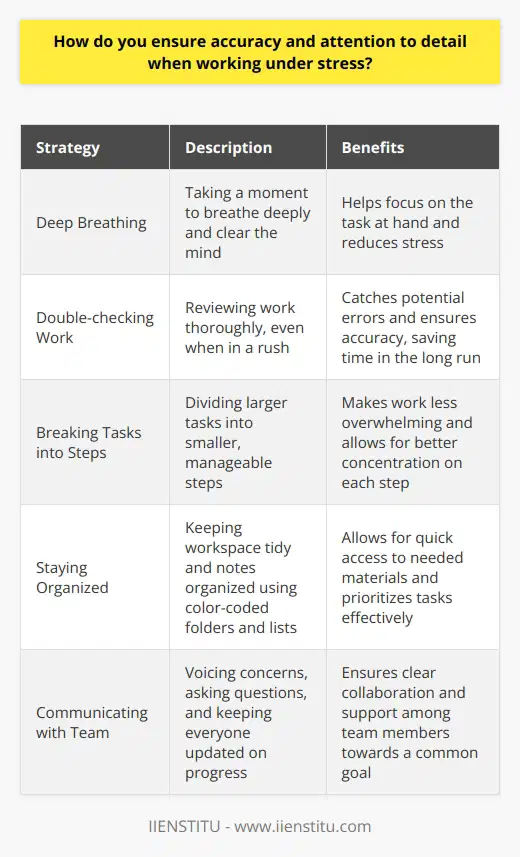
Can you provide an example of how you successfully managed a logistics crisis?
In my previous role as a logistics manager, I successfully managed a crisis when a supplier unexpectedly went bankrupt. This left us without critical components for our production line, jeopardizing our ability to meet customer deadlines.
Assessing the Situation
I quickly assembled my team to assess the situation and brainstorm solutions. We identified alternative suppliers and evaluated their capacity to meet our needs on short notice. It was a stressful time, but I remained calm and focused on finding a resolution.
Communicating with Stakeholders
I promptly communicated the issue to upper management and key customers impacted by potential delays. Transparency was crucial to maintaining trust and buy-in as we worked through the problem. I provided regular status updates to keep everyone informed of our progress.
Implementing a Solution
After securing a new supplier, I worked closely with them to expedite the delivery of components. This required creative problem-solving and flexibility to adjust our production schedule. I also coordinated with our transportation partners to ensure timely delivery to customers.
Learning from the Experience
Following the crisis, I conducted a thorough post-mortem with my team. We identified areas for improvement in our supply chain risk management and implemented new contingency plans. This experience strengthened my problem-solving skills and ability to lead under pressure.
In the end, we successfully met all customer deadlines with only minimal disruption to our operations. I'm proud of how my team pulled together and turned a potential disaster into an opportunity to showcase our resilience and commitment to customer satisfaction.
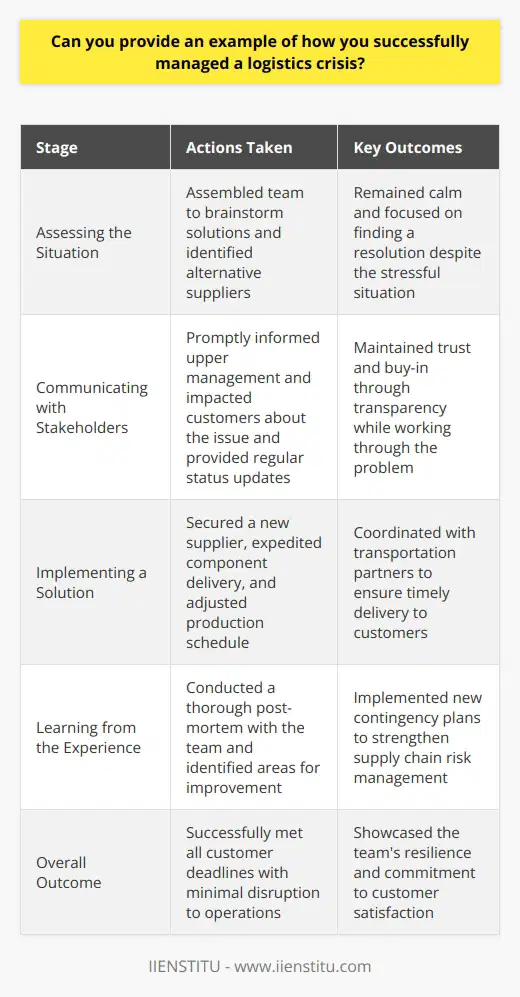
What methods do you use to continuously improve logistics processes and alleviate stress?
As a logistics professional, I'm always looking for ways to streamline processes and reduce stress. Here are some methods I use:
Continuous Improvement Through Data Analysis
I regularly review key metrics and performance data to identify bottlenecks and inefficiencies. Last quarter, I noticed our average shipment processing time had increased by 10%. By digging into the numbers, I discovered a software bug that was slowing things down. I worked with IT to quickly resolve it, bringing our times back in line.
Proactive Communication and Collaboration
Keeping everyone in the loop is critical for smooth logistics. I make it a point to regularly touch base with suppliers, carriers, and internal teams. Just last week, I learned about a potential delay from a key vendor. By getting out in front of it and coordinating with our production department, we were able to adjust our schedule and avoid any missed deliveries to customers.
Embracing Technology and Automation
I'm always on the lookout for new tools and systems to make our jobs easier. Implementing a transportation management system at my last company helped optimize our routes and reduce freight spend by 15%. But technology is only part of the solution. It's equally important to make sure your team is properly trained and bought into using it.
Effective Stress Management
Logistics can be high-pressure, so it's important to have good coping strategies. For me, that means regular exercise, meditation, and setting clear boundaries between work and personal time. If things ever start feeling overwhelming, I'm not afraid to ask for help. We're all in this together, and no one should have to shoulder the burden alone.
At the end of the day, improving logistics processes and managing stress is an ongoing journey. By staying proactive, embracing change, and supporting one another, I believe we can tackle any challenge that comes our way.
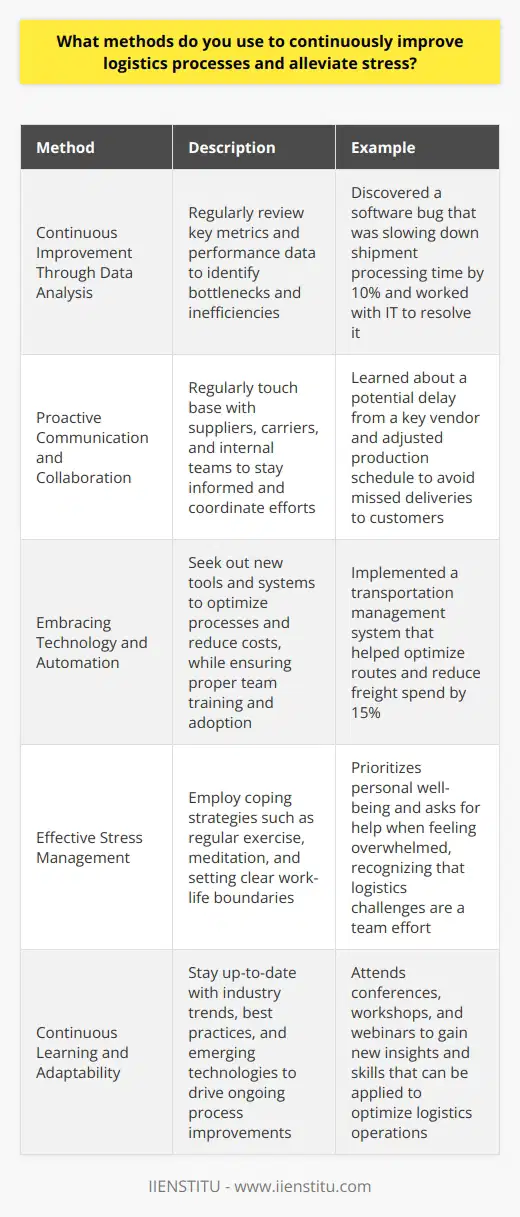
How do you prioritize self-care and stress management in your logistics career?
Prioritizing self-care and stress management is crucial in my logistics career. I understand that the job can be demanding and fast-paced, so I make sure to take care of myself both physically and mentally.
Maintaining a Healthy Work-Life Balance
One of the key ways I manage stress is by maintaining a healthy work-life balance. When I'm not at work, I disconnect and focus on activities that bring me joy and help me recharge. This could be spending time with family and friends, pursuing hobbies like hiking or painting, or simply relaxing at home with a good book.
Practicing Mindfulness and Meditation
I've found that practicing mindfulness and meditation helps me stay grounded and focused. Even just a few minutes of deep breathing or a quick meditation session during my break can make a big difference in reducing stress levels. It's a simple yet effective way to recenter myself amidst the chaos of the workday.
Prioritizing Physical Health
Taking care of my physical health is also a top priority. I make sure to eat a balanced diet, stay hydrated, and get enough sleep each night. Regular exercise is another important part of my self-care routine. Whether it's hitting the gym before work or going for a run during my lunch break, I find that physical activity helps me manage stress and maintain high energy levels throughout the day.
Communicating with Colleagues and Supervisors
Finally, I believe that open communication with colleagues and supervisors is key to managing stress in the workplace. When I'm feeling overwhelmed or need support, I don't hesitate to reach out and ask for help. By fostering strong relationships and creating a supportive work environment, we can all work together to prioritize self-care and maintain a healthy, productive team.
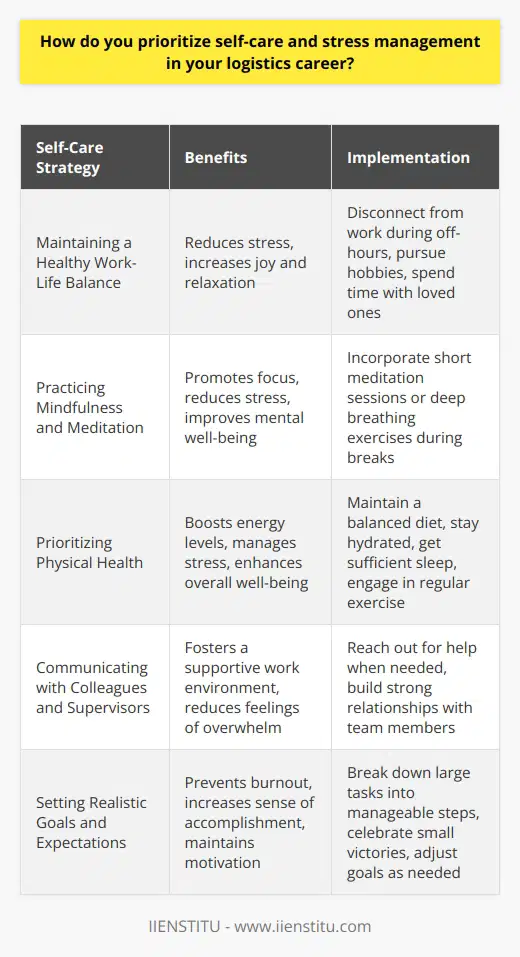
Can you describe a time when you had to make a difficult decision under pressure in a logistics role?
In my previous role as a logistics coordinator, I faced a challenging situation that required quick decision-making under pressure. Our company had a critical shipment scheduled for delivery to a major client, but our regular carrier unexpectedly went out of business.
Assessing the Situation
I quickly gathered all the relevant information about the shipment, including the destination, delivery deadline, and special requirements. I knew that any delay would jeopardize our relationship with the client and potentially lead to significant financial losses.
Exploring Alternative Solutions
I immediately started researching alternative carriers that could handle the shipment within the given timeframe. I reached out to my network of contacts in the logistics industry and sought recommendations for reliable and efficient carriers.
Making a Swift Decision
After evaluating the options, I selected a carrier that had a proven track record of handling time-sensitive deliveries. I negotiated the terms and rates to ensure that we could meet the client's expectations without compromising our budget.
Communicating and Coordinating
I promptly informed all the relevant stakeholders, including the client, about the change in carrier and the revised delivery schedule. I coordinated with our warehouse team to ensure that the shipment was properly packaged and ready for pickup by the new carrier.
Thanks to my quick thinking and decisive action, we successfully delivered the shipment to the client on time. This experience taught me the importance of staying calm under pressure, thinking creatively, and being proactive in finding solutions to unexpected challenges.
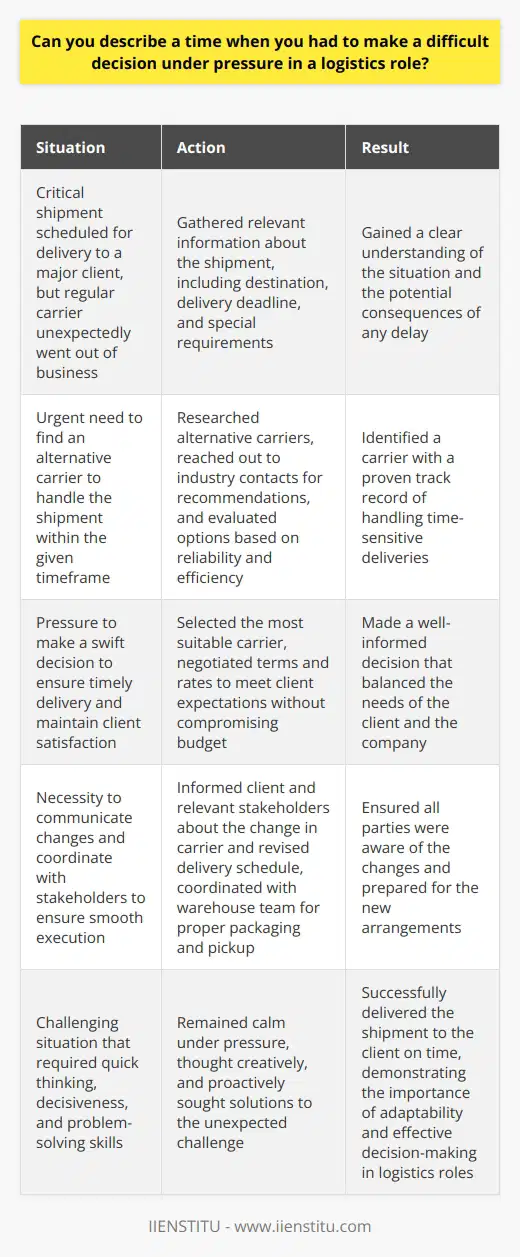
What techniques do you use to effectively delegate tasks and manage workload stress?
When it comes to delegating tasks effectively, I rely on a few key techniques. First, I assess the strengths and weaknesses of each team member. This allows me to assign tasks that play to their individual skills and abilities. Next, I provide clear instructions and expectations for each delegated task. I make sure everyone understands their role and the desired outcome. Regular check-ins and open communication are also crucial. I touch base with team members to monitor progress and offer support as needed.
Managing Workload Stress
To manage workload stress, I prioritize self-care and maintain a healthy work-life balance. I start each day with a few minutes of mindfulness meditation. This helps me feel centered and focused before diving into my to-do list. Throughout the day, I take short breaks to stretch, hydrate, and recharge. Even just 5-10 minutes away from my desk can make a big difference. When my workload feels overwhelming, I break projects down into smaller, more manageable tasks. Tackling things one step at a time keeps me from getting bogged down by stress. I also rely on my support system, both at work and in my personal life. Talking through challenges with colleagues, friends, or family helps me gain fresh perspective and stay motivated.
At the end of the day, delegating effectively and managing stress comes down to self-awareness emotional intelligence, and proactive coping skills. It's an ongoing learning process, but these strategies help me stay on track!
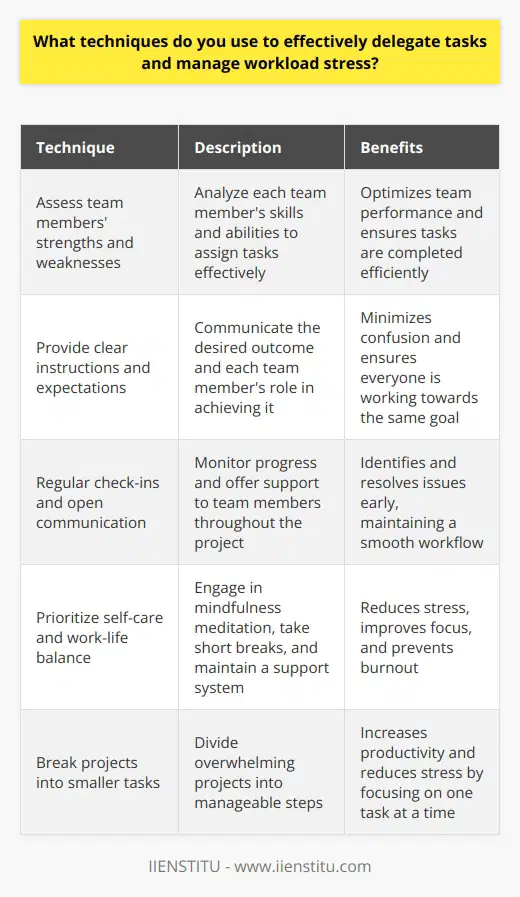
How do you stay motivated and focused during long, stressful logistics projects?
Staying motivated and focused during long, stressful logistics projects is all about mindset and balance. I've found that breaking down the project into smaller, manageable tasks helps me stay on track without feeling overwhelmed. Setting daily goals and celebrating small wins along the way keeps me motivated.
Prioritize Self-Care
I make sure to prioritize self-care, even during busy times. Taking short breaks to stretch, walk outside, or do some deep breathing exercises helps me recharge and maintain focus. After work, I unwind by pursuing hobbies like painting or playing guitar, which helps me come back to the project with fresh eyes.
Stay Organized
Staying organized is key to managing stress levels. I use project management tools to keep tasks, deadlines, and communications in one place. This helps me prioritize effectively and ensures nothing falls through the cracks, reducing anxiety.
Communicate Regularly
Regular communication with my team is essential for staying motivated. We have daily stand-up meetings to align on priorities, share progress, and address any roadblocks. Knowing that we're all working together towards a common goal is incredibly motivating, even during long projects.
Focus on the Big Picture
When I'm feeling stressed or bogged down in details, I try to step back and focus on the big picture - the impact this project will have on our customers and the company. Reminding myself of the purpose behind the work helps me stay motivated and push through challenging times.
At the end of the day, staying motivated during long projects is about finding a balance between hard work and self-care, staying organized and focused on the end goal. With the right mindset and strategies in place, even the most stressful projects can be incredibly rewarding.
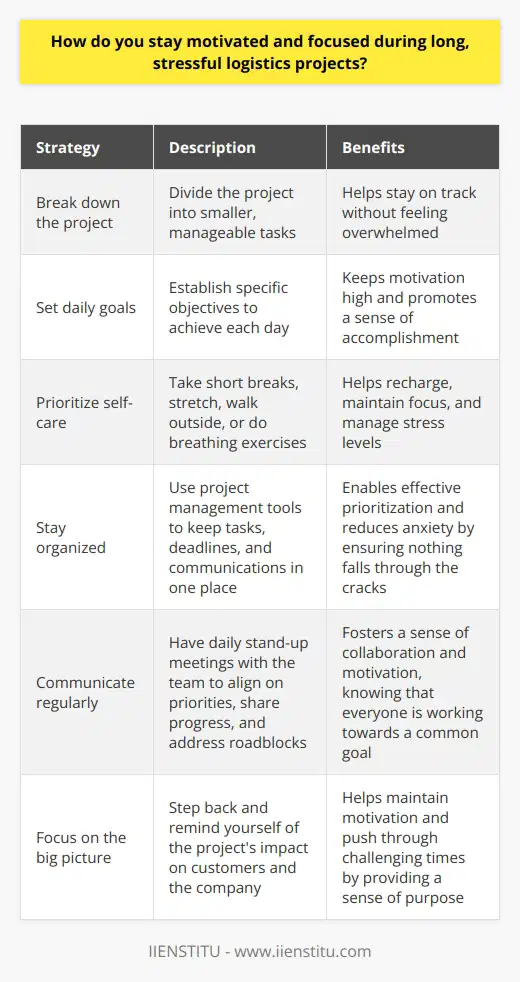
What strategies do you employ to build and maintain positive relationships with logistics partners?
To build and maintain positive relationships with logistics partners, I focus on clear communication and collaboration. I believe in setting clear expectations upfront and maintaining open lines of dialogue. This helps ensure everyone is on the same page.
Fostering Trust and Respect
Treating logistics partners with respect is key. I aim to be fair, honest, and considerate in all interactions. Building trust takes time, but it's essential for smooth operations. When issues arise, I approach them with patience and understanding.
Staying Proactive
I've found that anticipating potential challenges and addressing them early is crucial. By monitoring metrics and staying in close contact, problems can often be avoided. If delays or disruptions occur, I quickly communicate with all affected parties to find solutions.
Continuous Improvement
I'm always looking for ways to optimize processes and strengthen partnerships. Soliciting feedback, sharing best practices, and implementing changes together leads to better results. I recall one instance where a carrier shared an innovative tracking method that ended up improving visibility for multiple accounts.
Showing Appreciation
Finally, I believe in acknowledging great work and saying thank you. Whether it's meeting tight deadlines or going above and beyond, I make sure to recognize those efforts. A bit of genuine appreciation goes a long way in cementing strong relationships.
In summary, I've seen firsthand how focusing on communication, collaboration, and continuous improvement can transform logistics partnerships. It takes dedication, but the payoff is well worth it. These strategies have been integral to my approach and success in supply chain roles.

How do you handle the stress of meeting tight deadlines in a logistics environment?
I handle the stress of meeting tight deadlines in a logistics environment by staying organized and communicating effectively.
Prioritizing Tasks
I prioritize my tasks based on urgency and importance. This helps me focus on the most critical items first.
I create a daily to-do list and constantly update it as new tasks arise or priorities change.
Time Management
I'm a stickler for time management. I break down large projects into smaller, manageable tasks with specific deadlines.
I use calendar reminders and alerts to keep myself on track and avoid missing any important milestones.
Collaboration and Communication
I believe in the power of teamwork. I regularly communicate with my colleagues to ensure everyone is on the same page.
If I foresee any potential delays or issues, I promptly inform my supervisor and work on finding solutions.
Staying Calm Under Pressure
When the pressure is on, I take a moment to breathe deeply and focus on the task at hand.
I find that maintaining a positive attitude and staying level-headed helps me navigate even the most stressful situations.
Continuous Improvement
I'm always looking for ways to streamline processes and increase efficiency. I welcome feedback and suggestions from others.
After each project, I take time to reflect on what went well and identify areas for improvement moving forward.
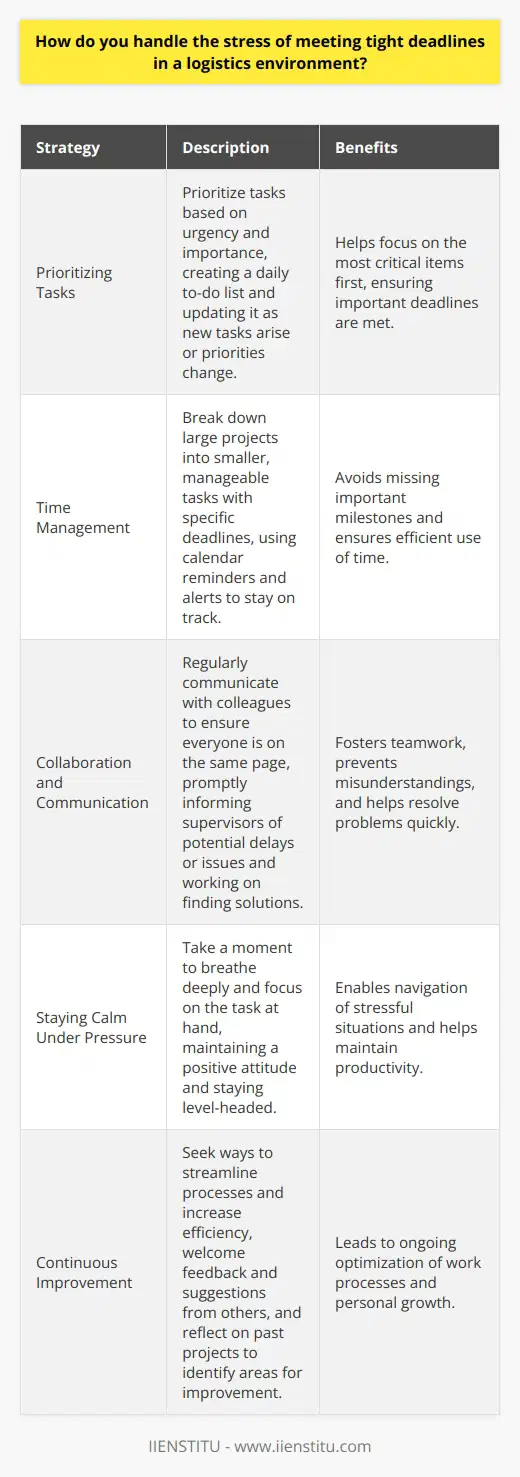
Can you describe your approach to risk management in high-pressure logistics situations?
When it comes to risk management in high-pressure logistics situations, I rely on a combination of thorough planning, quick thinking, and effective communication.
Thorough Planning
I always make sure to have contingency plans in place for potential issues that may arise. This allows me to quickly adapt and keep things moving smoothly, even when unexpected challenges come up.
Staying Calm Under Pressure
In my experience, staying calm and focused is key to making smart decisions when the pressure's on. I take a deep breath, assess the situation objectively, and then take decisive action to mitigate risks.
Clear Communication
I believe clear, concise communication is essential for effective risk management. I keep all stakeholders informed and work collaboratively to find solutions that keep projects on track.
Learning from Experience
Every high-pressure situation is an opportunity to learn and improve. I always take time to reflect afterwards, identifying what worked well and areas where I can refine my approach for even better results next time.
By combining these strategies, I'm able to effectively manage risks and consistently deliver successful outcomes, even in the most challenging logistics situations.
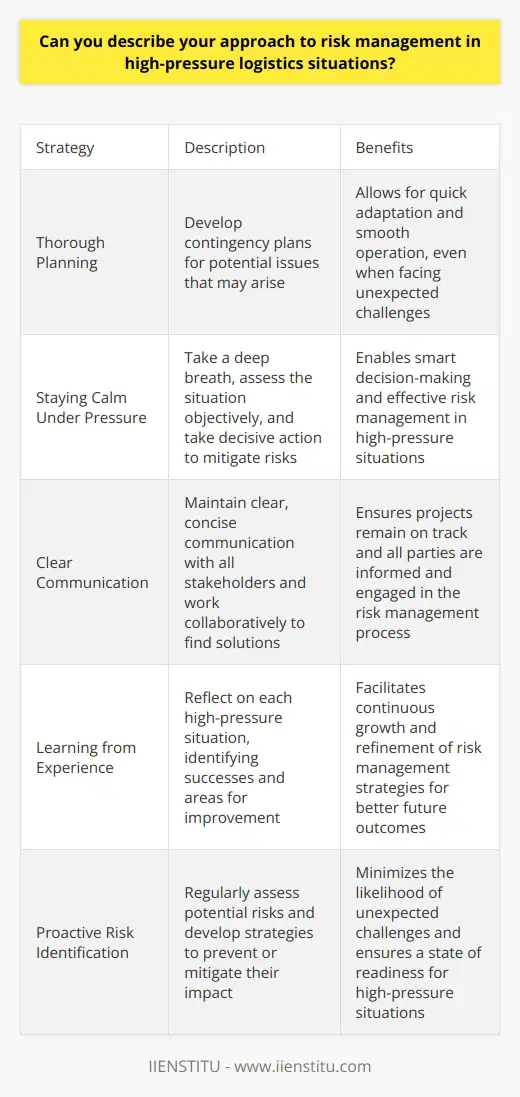
What methods do you use to prioritize and manage competing logistics priorities?
When managing competing logistics priorities, I focus on clear communication, adaptability, and a systematic approach. I start by gathering all relevant information and assessing the urgency and impact of each task. This helps me identify the most critical priorities.
Collaborating with Stakeholders
I collaborate closely with stakeholders to understand their needs and expectations. By fostering open dialogue, I can clarify requirements, negotiate deadlines, and find mutually beneficial solutions. Regular check-ins help me stay aligned with evolving priorities.
Leveraging Technology
I leverage technology to streamline processes and improve efficiency. Tools like project management software and real-time tracking systems help me monitor progress, identify bottlenecks, and make data-driven decisions. Automation also frees up time for high-value tasks.
Staying Agile and Adaptable
In logistics, unexpected challenges are inevitable. I stay agile by continuously reassessing priorities and adjusting plans as needed. Flexibility allows me to respond quickly to changes and minimize disruptions. I also build contingency plans for potential risks.
Continuous Improvement
I believe in continuous improvement. I regularly analyze my methods, seek feedback from colleagues, and explore industry best practices. By staying open to new ideas and embracing a growth mindset, I can refine my approach and deliver better results over time.
Ultimately, my goal is to balance competing priorities while ensuring timely and efficient logistics operations. Through proactive planning, collaboration, and adaptability, I strive to optimize resources and deliver exceptional service to all stakeholders.
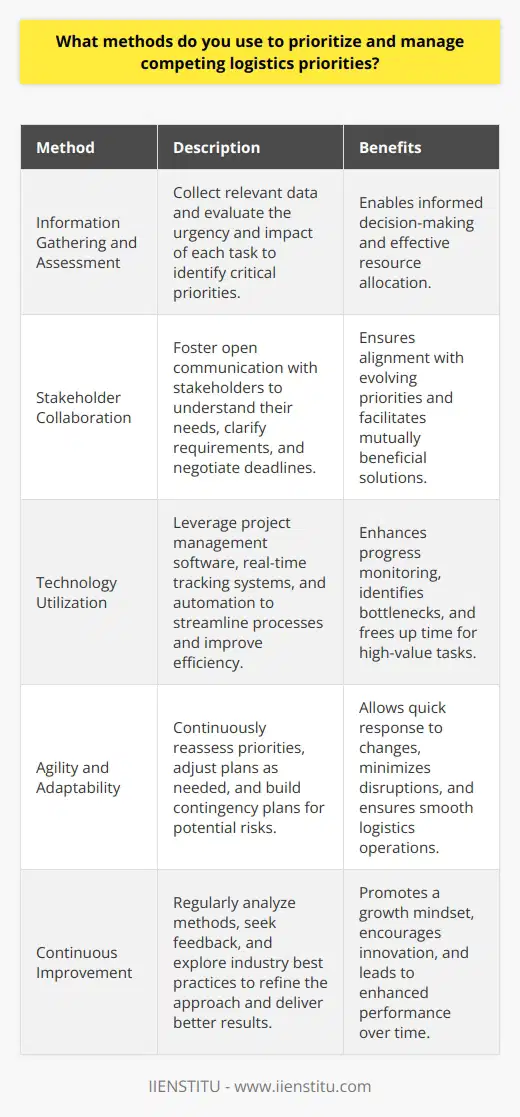
How do you maintain a positive attitude and inspire others during stressful logistics projects?
Maintaining a positive attitude during stressful logistics projects is essential for keeping the team motivated and focused. I believe that the key to staying positive is to keep the end goal in mind and to celebrate small victories along the way. When faced with challenges, I try to approach them with a problem-solving mindset and encourage open communication among team members.
Lead by Example
I find that one of the best ways to inspire others is to lead by example. When I remain calm and focused during stressful situations, it helps to set the tone for the rest of the team. I make an effort to stay organized, prioritize tasks, and maintain a positive outlook, even when things get tough.
Encourage Open Communication
Encouraging open communication is crucial for maintaining a positive team dynamic. I make sure to regularly check in with team members, listen to their concerns, and offer support and guidance when needed. By fostering an environment where everyone feels heard and valued, we can work together more effectively to overcome challenges.
Celebrate Small Victories
During long and stressful projects, it's important to take the time to celebrate small victories along the way. Whether it's completing a milestone or solving a difficult problem, acknowledging these successes helps to keep the team motivated and reminds us that we're making progress toward our ultimate goal.
Focus on Solutions
When faced with setbacks or challenges, I try to focus on finding solutions rather than dwelling on the problem. By approaching obstacles with a creative and proactive mindset, we can often find new and innovative ways to overcome them. I encourage my team to brainstorm ideas and work together to develop effective strategies for moving forward.
At the end of the day, maintaining a positive attitude during stressful logistics projects comes down to staying focused, communicating effectively, and supporting one another. By leading by example, celebrating successes, and focusing on solutions, we can create a strong and resilient team dynamic that allows us to tackle even the toughest challenges.

Can you provide an example of how you used data analysis to optimize logistics processes and reduce stress?
In my previous role as a logistics analyst, I successfully utilized data analysis to optimize processes and reduce stress. By carefully examining our transportation data, I identified inefficiencies in our routing and scheduling practices.
Identifying Improvement Opportunities
I began by gathering data from various sources, including GPS tracking, driver logs, and customer feedback. After cleaning and organizing the data, I conducted a thorough analysis to pinpoint areas for improvement. The insights I gained allowed me to develop targeted solutions to streamline our operations.
Implementing Data-Driven Solutions
One key finding was that our drivers were spending too much time navigating congested urban areas during peak hours. To address this, I proposed a dynamic routing system that adjusted routes based on real-time traffic data. By avoiding heavily congested areas, we reduced delivery times and driver stress levels.
Additionally, I discovered that our loading processes were inconsistent across different shifts. By standardizing procedures and implementing a data-driven loading plan, we minimized errors and improved efficiency. This not only reduced stress for our warehouse staff but also ensured timely deliveries to our customers.
Achieving Measurable Results
The data-driven solutions I implemented resulted in a 15% reduction in average delivery times and a 20% decrease in driver overtime hours. Moreover, customer satisfaction ratings improved by 12% due to more reliable and efficient service.
This experience taught me the power of leveraging data to drive meaningful improvements in logistics processes. I am confident that my skills in data analysis and process optimization can contribute to the success of your organization while fostering a less stressful work environment for our team.

What techniques do you use to effectively manage stress when working with cross-functional teams in logistics?
When working with cross-functional teams in logistics, I use several techniques to effectively manage stress:
Prioritize and Organize
I start by prioritizing tasks based on urgency and importance. This helps me focus on what matters most. I also break down complex projects into smaller, manageable steps to avoid feeling overwhelmed.
Communicate Clearly
Clear communication is key to reducing stress when collaborating with diverse teams. I make sure to express my expectations, deadlines, and challenges openly and honestly. Active listening helps me understand others' perspectives and find common ground.
Take Breaks
When stress levels rise, I step away from my desk for a few minutes. A quick walk or some deep breathing exercises can work wonders. These short breaks help me recharge and approach problems with a fresh mindset.
Stay Positive
I try to maintain a positive attitude, even in challenging situations. Focusing on solutions rather than dwelling on problems keeps me motivated. Celebrating small victories along the way boosts morale for the entire team.
Learn from Mistakes
I view mistakes as opportunities for growth and learning. Instead of getting frustrated, I analyze what went wrong and brainstorm ways to improve. This mindset helps me stay resilient and adaptable in the face of stress.
By using these techniques consistently, I'm able to manage stress effectively while collaborating with cross-functional teams. It's an ongoing process, but one that leads to better outcomes and a healthier work environment for everyone involved.
